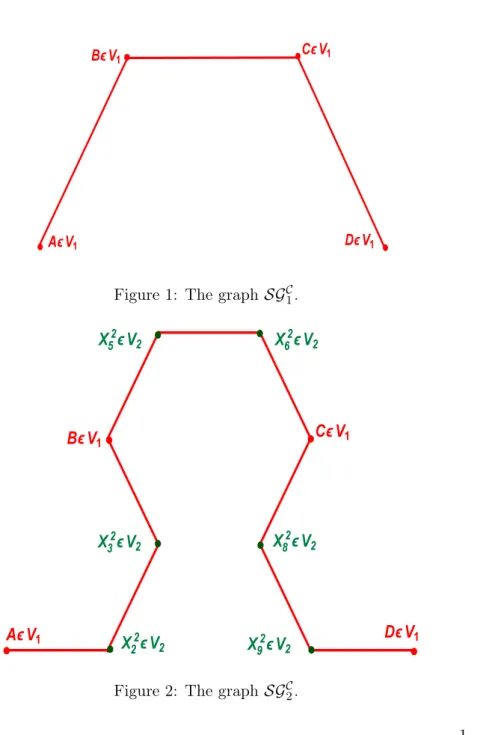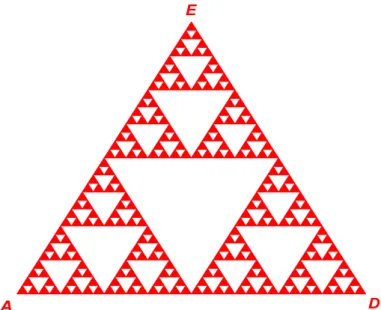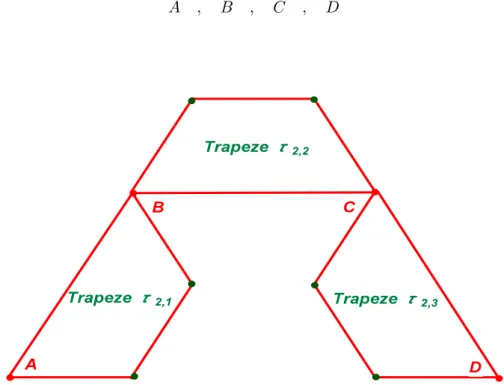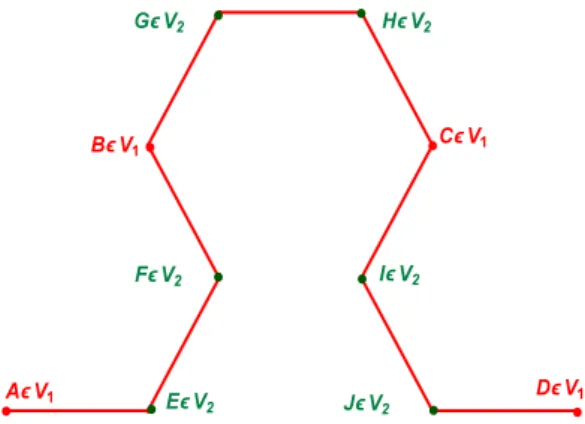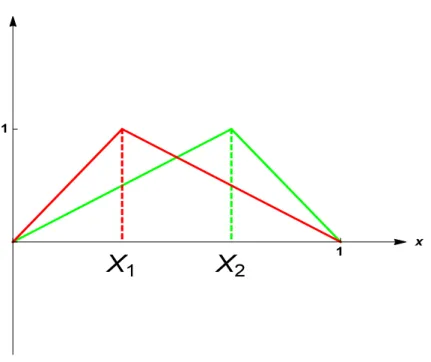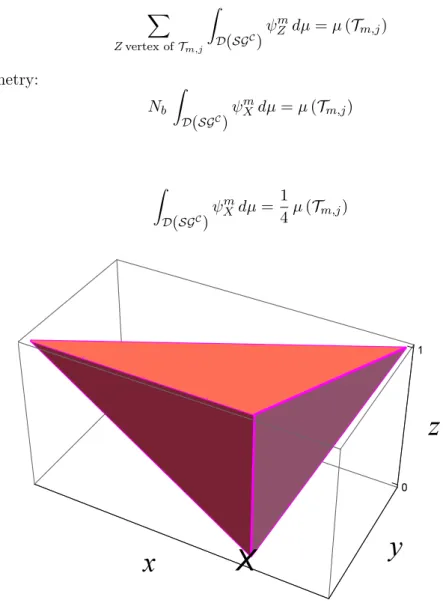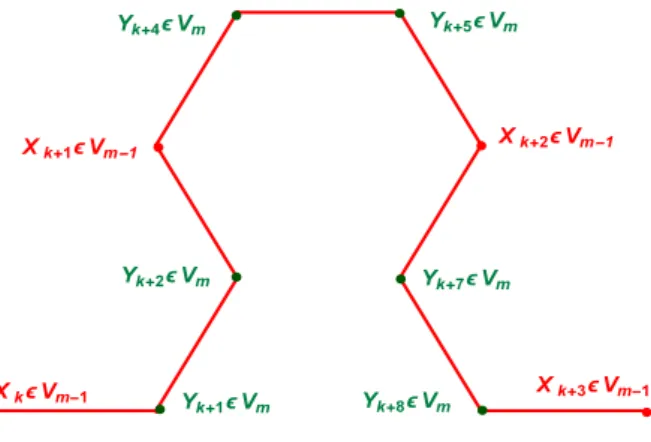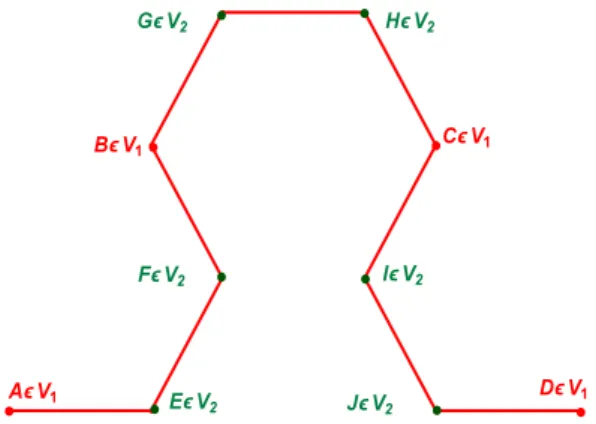HAL Id: hal-01508884
https://hal.sorbonne-universite.fr/hal-01508884
Preprint submitted on 14 Apr 2017HAL is a multi-disciplinary open access
archive for the deposit and dissemination of sci-entific research documents, whether they are pub-lished or not. The documents may come from teaching and research institutions in France or abroad, or from public or private research centers.
L’archive ouverte pluridisciplinaire HAL, est destinée au dépôt et à la diffusion de documents scientifiques de niveau recherche, publiés ou non, émanant des établissements d’enseignement et de recherche français ou étrangers, des laboratoires publics ou privés.
A note on energy forms on fractal domains
Claire David
To cite this version:
A note on energy forms on fractal domains
Claire David
April 14, 2017
Sorbonne Universités, UPMC Univ Paris 06
CNRS, UMR 7598, Laboratoire Jacques-Louis Lions, 4, place Jussieu 75005, Paris, France
1
Introduction
In [1], [2], J. Kigami has laid the foundations of what is now known as analysis on fractals, by allowing the construction of an operator of the same nature of the Laplacian, defined locally, on graphs having a fractal character. The Sierpiński gasket stands out of the best known example. It has, since then, been taken up, developed and popularized by R. S. Strichartz [4], [20].
The Laplacian is obtained through a weak formulation, obtained by means of Dirichlet forms, built by induction on a sequence of graphs that converges towards the considered domain. It is these Dirich-let forms that enable one to obtain energy forms on this domain.
Yet, things are not that simple. If, for domains like the Sierpiński gasket, the Laplacian is obtained in a quite natural way, one must bear in mind that Dirichlet forms solely depend on the topology of the domain, and not of its geometry. Which means that, if one aims at building a Laplacian on a fractal domain, the topology of which is the same as, for instance, a line segment, one has to find a way of taking account a very specific geometry. We came across that problem in our work on the graph of the Weierstrass function [6]. The solution was thus to consider energy forms more sophisticated than classical ones, by means of normalization constants that could, not only bear the topology, but, also, the very specific geometry of, from now on, we will callW−curves.
It is interesting to note that such problems do not seem to arise so much in the existing literature. In a very general way, one may refer to [8], where the authors build an energy form on non-self similar closed fractal curves, by integrating the Lagrangian on this curve.
We presently aim at investigating the links between energy forms and geometry. We have chosen to consider fractal curves, specifically, the Sierpiński arrowhead curve, the limit of which is the Sierpiński gasket. Does one obtain the same Laplacian as for the triangle ? The question appears as worth to be investigated.
2
Framework of the study
We place ourselves, in the following, in the Euclidean plane of dimension 2, referred to a direct or-thonormal frame. The usual Cartesian coordinates are (x, y).
Notation. Given a point X ∈ R2, we will denote by: i. SimX,1
2, π
3 the similarity of ratio
1
2, the center of which is X, and the angle, π 3 ; ii. SimX,1
2,− π
3 the similarity of ratio
1
2, , the center of which is X, and the angle,− π 3.
Definition 2.1. Let us consider the following points ofR2: A = (0, 0) , D = (1, 0) , B =SimX,1 2, π 3(D) , C =SimX, 1 2,− π 3(A)
We will denote by V1 the ordered set, of the points:
{A, B, C, D}
The set of points V1, where A is linked to B, B is linked to C, and where C is linked to D, constitutes
an oriented graph, that we will denote bySGC1. V1 is called the set of vertices of the graphSGC1.
Let us build by induction the sequence of points: (Vm)m∈N⋆ = ( Xjm)16j6NS m, m∈N⋆ , NmS ∈ N⋆ such that: X11 = A , X21= B , X31= A , X41 = D and for any integers m> 2, 0 6 j 6 NmS, k ∈ N, ℓ ∈ N:
Xj+km = Xjm−1 if k≡ 0 [3] Xj+k+ℓm =SimXm−1 j , 1 2,(−1)m+1+ℓ π3 ( Xj+1m−1 ) if k≡ 1 [3] and ℓ ∈ 2 N Xj+k+ℓm =SimXm−1 j+1 , 1 2,(−1)m+ℓ π3 ( Xjm−1 ) if k≡ 2 [3] and ℓ ∈ N \ 2 N
The set of points Vm, where two consecutive points are linked, is an oriented graph, which we will
denote bySGCm. Vm is called the set of vertices of the graphSGCm.
Property 2.1. For any strictly positive integer m: Vm ⊂ Vm+1
Property 2.2. If one denotes by (SGm)m∈N the sequence of graphs that approximate the Sierpiński
gasketSG, then, for any strictly positive integer m: SGC
m ( SGm
Definition 2.2. Sierpiński arrowhead curve We will denote by SGC the limit:
SGC= lim
m→+∞SG
C m
which will be called the Sierpiński arrowhead curve.
Property 2.3. Let us denote by SG the Sierpiński Gasket. Then: lim
m→+∞SG
C
m =SGC=SG
Remark 2.1. The sequence of graphs (SGm)m∈N⋆ can also be seen as a Lindenmayer system
("L-system"), i.e. a set (V, ω, P ), where V denotes an alphabet (or, equivalently, the set of constant elements and rules, and variables), ω, the initial state (also called "axiom"), and P , the production rules, which are to be applied, iteratively, to the initial state.
In the case of the Sierpiński arrowhead curve, if one denotes by: i. F the rule: "Draw forward, on one unit length" ;
ii. + the rule: "Turn left, with an angle of π 3" ; iii. − the rule: "Turn right, with an angle of π
3" ; then:
i. the variables can be denoted by X and Y ; ii. the constants are F , +,− ;
iii. the initial state is XF ; iv. the production rules are:
Figure 1: The graph SGC1.
Figure 2: The graph SGC2.
Notation. Given a point X ∈ R2, we will denote by HX,1
2 the homothecy of ratio
1
2, the center of which is X,.
Property 2.4. Self-similarity properties of the Sierpiński arrowhead curve
Let us denote by E the point of R2 such that A, D and E are the consecutive vertices of a direct equilateral triangle. One may note that A, D and E are, also, the frontier vertices of the Sierpiński gasketSG.
Figure 3: The graph SGC4.
Figure 4: The graph SGC7.
H1=HA,1 2 , H2 =HD, 1 2 , H3=HE, 1 2
Proof. The result comes from the self-similarity of the Sierpiński Gasket with respect to those homote-cies: SG = 3 ∪ i=1 Hi(SG)
Figure 5: The points A, D and E, as frontier vertices of the Sierpiński gasket.
Property 2.5. The sequence(NmS)m∈N is an arithmetico-geometric one, with N1S= 4 as first term: ∀ m ∈ N : Nm+1S = 4 ( NmS− 1 ) −(NmS− 1 ) = 3NmS− 2 This leads to:
∀ m ∈ N⋆ : NS m+1 = 3m ( NS 1 − 1 ) + 1 = 3m+1+ 1
Definition 2.3. Consecutive vertices on the graph SGC
Two points X and Y of SGC will be called consecutive vertices of the graph SGC if there exists a natural integer m, and an integer j of{1, ...,NmS− 1}, such that:
X = Xjm and Y = Xj+1m or:
Y = Xjm and X = Xj+1m
Definition 2.4. For any positive integer m, the NmS consecutive vertices of the graphSGCm are, also, the vertices of 3m−1 trapezes Tm,j, 16 j 6 3m−1. For any integer j such that 16 j 6 3m−1, one
ob-tains each trapeze by linking the point number j to the point number j + 1 if j = i mod 4, 06 i 6 2, and the point number j to the point number j− 3 if j = −1 mod 4. These trapezes generate a Borel set ofR2.
In the sequel, we will denote byT1 the initial trapeze, the vertices of which are, respectively:
A , B , C , D
Figure 6: The trapezes T2,1,T2,2 and T2,3.
Definition 2.5. Trapezoidal domain delimited by the graph SGCm, m ∈ N
For any natural integer m, well call trapezoidal domain delimited by the graphSGCm, and denote byD(SGCm), the reunion of the 3m−1 trapezes Tm,j, 16 j 6 3m−1.
Property 2.6. Taking into account that the Lebesgue measure of the first trapeze T1 is given by:
A1 =A (T1) =
√ 3 4
one obtains, for any natural integer m > 1, the Lebesgue measure of a trapeze Tm,j, 16 j 6 3m−1 by
noticing that each trapeze is, also, the reunion of three equilateral triangles.
Thus, for any natural integer m> 2, the Lebesgue measure of a trapeze Tm,j, 16 j 6 3m−1 is given
by:
Am =A (Tm,j) =
3A1
4m
Definition 2.6. Trapezoidal domain delimited by the graph SGC
We will call trapezoidal domain delimited by the graph SGC, and denote byD(SGC), the limit: D(SGC)= lim m→+∞D ( SGC m )
Notation. In the sequel, we will denote by dR2 the Euclidean distance onR2.
Definition 2.7. Edge relation, on the graph SGC
Given a natural integer m, two points X and Y ofSGCmwill be calledadjacent if and only if X and Y are two consecutive vertices ofSGCm. We will write:
X ∼
m Y
Given two points X and Y of the graph SGC, we will say that X and Y are adjacent if and only if there exists a natural integer m such that:
X ∼
m Y
Property 2.7. Euclidean distance of two adjacent vertices of SGCm, m ∈ N Given a natural integer m, and two points X and Y of SGCm such that X ∼
mY :
dR2(X, Y ) =
1 2m
Property 2.8. The set of vertices (Vm)m∈N is dense in SGC.
Definition 2.8. Measure, on the domain delimited by the graph SGC
We will call domain delimited by the graph SGC, and denote byD(SGC), the limit: D(SGC)= lim n→+∞D ( SGC m )
which has to be understood in the following way: given a continuous function u on the graph SGC, and a measure with full support µ onR2, then:
∫ D(SGC)u dµ =mlim→+∞ 3∑m−1 j=1 ∑ X vertex ofTm,j u (X) µ (Tm,j)
We will say that µ is a measure, on the domain delimited by the graph SGC.
Definition 2.9. Dirichlet form (we refer to the paper [14], or the book [23])
Given a measured space (E, µ), a Dirichlet form on E is a bilinear symmetric form, that we will denote byE, defined on a vectorial subspace D dense in L2(E, µ), such that:
2. D, equipped with the inner product which, to any pair (u, v) of D× D, associates: (u, v)E = (u, v)L2(E,µ)+E(u, v)
is a Hilbert space.
3. For any real-valued function u defined on D, if:
u⋆ = min (max(u, 0), 1) ∈ D
then : E(u⋆, u⋆)6 E(u, u) (Markov property, or lack of memory property).
Definition 2.10. Dirichlet form, on a finite set ([2])
Let V denote a finite set V , equipped with the usual inner product which, to any pair (u, v) of functions defined on V , associates:
(u, v) = ∑
p∈V
u(p) v(p) ADirichlet form on V is a symmetric bilinear form E, such that:
1. For any real valued function u defined on V : E(u, u) > 0. 2. E(u, u) = 0 if and only if u is constant on V .
3. For any real-valued function u defined on V , if:
u⋆= min (max(u, 0), 1) i.e. : ∀ p ∈ V : u⋆(p) = 1 if u(p)> 1 u(p) si 0 < u(p) < 1 0 if u(p)6 0 then: E(u⋆, u⋆)6 E(u, u) (Markov property).
Notation. Let us denote by:
DSGC = DSG = ln 3
ln 2
the box-dimension (equal to the Hausdorff dimension), of the Sierpiński arrow curveSGC. For the sake of simplicity, we will from now on denote it by DSG.
Let us now consider the problem of energy forms on our curve. The following points have to be taken into account:
i. As mentioned in the preamble of this work, Dirichlet forms solely depend on the topology of the sequence of graphs that approximate our curve.
ii. Our curve is, indeed, self-similar, yet, it cannot be obtained by means of an iterated function system, as it is the case with the Sierpiński gasket, or theW−curve we studied in [6].
Such a problem was studied by U. Mosco [7], who specifically considered the case of what he called "the Sierpiński curve", or "Sierpiński string". Yet, he did not dealt with the curve itself, but with the Sierpiński gasket: "2D branches (...) meet together". Contrary to the arrow curve, the Sierpiński gasket exhibits self-similarity properties which turn it into a post-critically finite fractal (pcf fractal).
Yet, one can find interesting ideas in the work of U. Mosco. For instance, he suggests to generalize Riemaniann models to fractals and relate the fractal analogous of gradient forms, i.e. the Dirichlet forms, to a metric that could reflect the fractal properties of the considered structure. The link is to be made by means of specific energy forms.
There are two major features that enable one to characterize fractal structures: i. Their topology, i.e. their ramification.
ii. Their geometry.
The topology can be taken into account by means of classical energy forms (we refer to [1], [2], [4], [20]).
As for the geometry, again, things are not that simple to handle. U. Mosco introduces a strictly positive parameter, δ, which is supposed to reflect the way ramification - or the iterative process that gives birth to the sequence of graphs that approximate the structure - affects the initial geometry of the structure. For instance, if m is a natural integer, X and Y two points of the initial graph V1, and M
a word of length m, the Euclidean distance dR2(X, Y ) between X and Y is changed into the effective
distance:
(dR2(X, Y ))δ
This parameter δ appears to be the one that can be obtained when building the effective resistance metric of a fractal structure (see [20]), which is obtained by means of energy forms. To avoid turning into circles, this means:
i. either working, in a first time, with a value δ0 equal to one, and, then, adjusting it when building
the effective resistance metric ; ii. using existing results, as done in [8].
In the case of the arrow curve, at a step m ∈ N⋆of the iteration process, the distance between two adjacent points of SGCm is the same as the one between two adjacent points of the graph SGm, and
take:
δ = ln 5 ln 4
Definition 2.11. Energy, on the graph SGCm, m ∈ N, of a pair of functions Let m be a natural integer, and u and v two real valued functions, defined on the set
Vm= { X1m, . . . , XNmS m } of theNmS vertices of SGCm.
We introduce the energy, on the graph SGCm, of the pair of functions (u, v), as:
ESGC m(u, v) = NS m−1 ∑ i=1 ( u (Xim)− u(Xi+1m ) dδR2(X, Y ) ) ( v (Xim)− v(Xi+1m ) dδR2(X, Y ) ) = NS m−1 ∑ i=1 22 m δ (u (Xim)− u(Xi+1m )) (v (Xim)− v(Xi+1m )) For the sake of simplicity, we will write it under the form:
ESGC
m(u, v) =
∑
X∼
mY
4m δ (u(X)− u(Y )) (v(X) − v(Y ))
Property 2.9. Given a natural integer m, and a real-valued function u, defined on the set of vertices of SGCm, the map, which, to any pair of real-valued, continuous functions (u, v) defined on the set Vm
of the Nm vertices of SGCm, associates:
ESGC
m(u, v) =
∑
X∼
mY
4m δ (u(X)− u(Y )) (v(X) − v(Y ))
is a Dirichlet form onSGCm. Moreover:
ESGC
m(u, u) = 0⇔ u is constant
Proposition 2.10. Harmonic extension of a function, on the graph of Sierpiński arrow curve - Ramification constant
For any integer m > 1, if u is a real-valued function defined on Vm−1, its harmonic extension,
denoted by ˜u, is obtained as the extension of u to Vm which minimizes the energy:
ESGC m(˜u, ˜u) = ∑ X∼ mY 4m δ(˜u(X)− ˜u(Y ))2
The link between ESGC
m and ESGCm−1 is obtained through the introduction of two strictly positive
con-stants rm and rm+1 such that:
rm ∑ X∼ mY 4m δ(˜u(X)− ˜u(Y ))2 = rm−14m δ ∑ X ∼ m−1Y (u(X)− u(Y ))2 In particular:
r242 δ ∑ X∼ 1Y (˜u(X)− ˜u(Y ))2 = r14δ ∑ X∼ 1Y (u(X)− u(Y ))2
For the sake of simplicity, we will fix the value of the initial constant: r1= 1. One has then:
ESGC m(˜u, ˜u) = 1 r1ESG C 1(˜u, ˜u) Let us set: r = 1 r1 and: Em(u) = rm ∑ X∼ mY 4m δ(˜u(X)− ˜u(Y ))2
Since the determination of the harmonic extension of a function appears to be a local problem, on the graph ΓWm−1, which is linked to the graphSGCm by a similar process as the one that links SGC2 to SGC1,
one deduces, for any integer m > 2: ESGC m(˜u, ˜u) = 1 r1ESG C m−1(˜u, ˜u)
By induction, one gets:
rm = rm1 = r−m= 3−m
If v is a real-valued function, defined on Vm−1, of harmonic extension ˜v, we will write:
Em(u, v) = r−m
∑
X∼
mY
4m δ(˜u(X)− ˜u(Y )) (˜v(X) − ˜v(Y ))
The constant r−1, which can be interpreted as a topological one, will be calledramification constant. For further precision on the construction and existence of harmonic extensions, we refer to [13].
Remark 2.2. Determination of the ramification constant r
Let us denote by u a real-valued, continuous function defined on V1, and by ˜u its harmonic extension
to V2.
Let us denote by a, b, c and d the values of u on the four consecutive vertices of V1 (see the following
figure):
u(A) = a , u(B) = b , u(C) = c , u(D) = d and by:
i. e and f the values of ˜u on the two consecutive vertices E and F that are between A and B: u(E) = e , u(F ) = f
ii. g and h the values of ˜u on the two consecutive vertices G and H that are between B and C: u(G) = g , u(H) = h
Figure 7: Determination of the ramification constant between graphs of level 1 and 2. iii. i and j the values of ˜u on the two consecutive vertices I and J that are between C and D:
u(I) = i , u(J ) = j One has: ESGC 1(˜u, ˜u) = (a− b 2+ (b− c)2+ (c− d)2 ESGC 2(˜u, ˜u) = (a− e) 2+ (e− f)2+ (b− f)2+ (g− b)2+ (h− g)2+ (c− h)2+ (i− c)2+ (j− i)2+ (d− j)2
Since the harmonic extension ˜u minimizes ESGC
2, the values of e, f , g, h, i, j are to be found among
the critical points e, f , g, h, i, j such that: ∂ESGC 2(˜u, ˜u) ∂e = 0 , ∂ESGC 2(˜u, ˜u) ∂f = 0 , ∂ESGC 2(˜u, ˜u) ∂g = 0 , ∂ESGC 2(˜u, ˜u) ∂h = 0 , ∂ESGC 2(˜u, ˜u) ∂i = 0 , ∂ESGC 2(˜u, ˜u) ∂j = 0 This leads to:
e = 2 a + b) 3 , f = 2 (a + 2 b) 3 , g = 2 b + c 3 , h = 2 (b + 2 c) 3 , i = 2 c + d) 3 , j = 2 (c + 2 d) 3 and: ESGC 2(˜u, ˜u) = 1 3ESGC2(˜u, ˜u) Thus: r−1= 1 3
One may note that the ramification constant is exactly equal to one plus the number of points that arise in Vm+1, for any value of the strictly positive integer m, between two consecutive vertices of Vm.
We thus fall back on the results we previously obtained in [18], [6] for the graph of the Weierstrass function.
Definition 2.12. Energy scaling factor
By definition, the energy scaling factor is the strictly positive constant ρ such that, for any inte-ger m > 1, and any real-valued function u defined on Vm:
ESGC
m(u, u) = ρESGCm
(
Proposition 2.11. The energy scaling factor ρ is linked to the topology and the geometry of the fractal curve by means of the relation:
ρ = 4
δ
3
Definition 2.13. Dirichlet form, for a pair of continuous functions defined on the graphSGC We define the Dirichlet form E which, to any pair of real-valued, continuous functions (u, v) defined on the Sierpiński arrow curveSGC, associates, subject to its existence:
E(u, v) = lim m→+∞Em ( u|Vm, v|Vm)= lim m→+∞ ∑ X∼ mY r−m4m δ (u|Vm(X)− u|Vm(Y )) (v|Vm(X)− v|Vm(Y ))
Definition 2.14. Normalized energy, for a continuous function u, defined on the Sierpiński arrow curve
Taking into account that the sequence(Em
( u|Vm))m∈N is defined on V⋆ = ∪ i∈N Vi
one defines the normalized energy, for a continuous function u, defined on the curveSGC, by: E(u) = lim
m→+∞Em
( u|Vm)
Notation. We will denote by domE the subspace of continuous functions defined on SGC, such that: E(u) < +∞
Notation. We will denote by dom1E the subspace of continuous functions defined on SGC, which take
the value on V1, such that:
3
Laplacian of a continuous function, on the Sierpiński arrowhead
curve
Definition 3.1. Self-similar measure, on the graph of the Sierpiński arrow curve
A measure µ on R2 will be said to be self-similar for the domain delimited by the Sierpiński arrow
curve, if there exists a family of strictly positive pounds (µ1, µ2, µ3) such that:
µ = 3 ∑ i=1 µiµ◦ Hi−1 , 3 ∑ i=1 µi= 1
For further precisions on self-similar measures, we refer to the works of J. E. Hutchinson (see [?]).
Property 3.1. Building of a self-similar measure, for the domain delimited by the Sier-piński arrow curve
The Dirichlet forms mentioned in the above require a positive Radon measure with full support. The choice of a self-similar measure, which is, mots of the time, built with regards to a reference set, of measure 1, appears, first, as very natural. R. S. Strichartz [3], [4], showed that one can simply consider auto-replicant measures ˜µ, i.e. measures ˜µ such that:
˜ µ = 3 ∑ i=1 ˜ µiµ˜◦ H−1i (⋆)
where (˜µ1, ˜µ2, ˜µ3) denotes a family of strictly positive pounds.
This latter approach appears as the best suited in our study, since, in the case of the graphSGC, the ini-tial set consists of the trapezeT0, the measure of which, equal to its surface, is not necessarily equal to 1.
Let us assume that there exists a measure ˜µ satisfying (⋆).
Relation (⋆) yields, for any set of trapezes Tm,j, m ∈ N, 1 6 j 6 3m−1:
˜ µ ∪ 16j63m−1 Tm,j =∑3 i=1 ˜ µiµ˜ H−1 i ∪ 16j63m−1 Tm,j and, in particular: ˜ µ (H1(T1)∪ H2(T1)∪ H3(T1)) = 3 ∑ i=1 ˜ µiµ (˜ T1) i.e.: 3 ∑ i=1 ˜ µ (Hi(T1)) = 3 ∑ i=1 ˜ µiµ (˜ T1)
The convenient choice, for any i of{1, 2, 3} , is: ˜ µi = ˜ µ (Hi(T1)) ˜ µ (T1) = 3 4
µ =
3
∑
i=1
µiµ◦ H−1i
where (µi)16i63 is a family of strictly positive pounds, the sum of which is equal to 1.
One has simply to set, for any i of {1, 2, 3} : µi =
4 ˜µi
9
The measure µ is self-similar, for the domain delimited by the Sierpiński arrowhead curve.
Definition 3.2. Laplacian of order m ∈ N⋆
For any strictly positive integer m, and any real-valued function u, defined on the set Vm of the vertices
of the graph SGCm, we introduce the Laplacian of order m, ∆m(u), by:
∆mu(X) =
∑
Y∈Vm, Y∼ mX
(u(Y )− u(X)) ∀ X ∈ Vm\ V0
Definition 3.3. Harmonic function of order m ∈ N⋆
Let m be a strictly positive integer. A real-valued function u,defined on the set Vm of the vertices of
the graphSG⌋m, will be said to be harmonic of order m if its Laplacian of order m is null:
∆mu(X) = 0 ∀ X ∈ Vm\ V0
Definition 3.4. Piecewise harmonic function of order m ∈ N⋆
Given a strictly positive integer m, a real valued function u, defined on the set of vertices of SGC, is said to be piecewise harmonic function of order m if, for any wordM of length m, u ◦ TM is harmonic of order m.
Definition 3.5. Existence domain of the Laplacian, for a continuous function on the graph SGC (see [14])
We will denote by dom ∆ the existence domain of the Laplacian, on the graph SGC, as the set of functions u of domEsuch that there exists a continuous function on SGC, denoted ∆ u, that we will call Laplacian of u, such that :
E(u, v) = − ∫
D(SGC)v ∆u dµ for any v ∈ dom1E
Notation. In the following, we will denote byH0 ⊂ dom ∆ the space of harmonic functions, i.e. the
space of functions u ∈ dom ∆ such that:
∆ u = 0
Given a natural integer m, we will denote byS (H0, Vm) the space, of dimension Nbm, of spline functions
" of level m", u, defined on SGC, continuous, such that, for any word M of length m, u ◦ TM is harmonic, i.e.:
∆m (u◦ TM) = 0
Property 3.2. For any natural integer m:
S (H0, Vm)⊂ dom E
Property 3.3. Let m be a strictly positive integer, X /∈ V0a vertex of the graphSGC, and ψXm ∈ S (H0, Vm)
a spline function such that: ψmX(Y ) = { δXY ∀ Y ∈ Vm 0 ∀ Y /∈ Vm , where δXY = { 1 if X = Y 0 else
Then, since X /∈ V0: ψmX ∈ dom1E.
For any function u of domE, such that its Laplacian exists, definition (3.5) applied to ψm
X leads to: E(u, ψm X) = η2−2−DWEm(u, ψXm) =−r−mη2−2−DW∆mu(X) =− ∫ D(SGC)ψ m X∆u dµ≈ −∆u(X) ∫ D(SGC)ψ m Xdµ
since ∆u is continuous on SGC, and the support of the spline function ψXm is close to X: ∫ D(SGC)ψ m X ∆u dµ≈ −∆u(X) ∫ D(SGC)ψ m X dµ
By passing through the limit when the integer m tends towards infinity, one gets: lim m→+∞ ∫ D(SGC)ψ m X∆mu dµ = ∆u(X) lim m→+∞ ∫ D(SGC)ψ m X dµ i.e.: ∆u(X) = lim m→+∞r −m4m δ (∫ D(SGC)ψ m X dµ )−1 ∆mu(X)
4
Explicit determination of the Laplacian of a function u of dom ∆
The explicit determination of the Laplacian of a function u of dom ∆ requires to know: ∫
D(SGC)ψ
m X dµ
As it is explained in [20], one has just to reason by analogy with the dimension 1, more particulary, the unit interval I = [0, 1], of extremities X0 = (0, 0), and X1 = (1, 0). The functions ψX1 and ψX2
such that, for any Y ofR2 :
ψX1(Y ) = δX1Y , ψX2(Y ) = δX2Y
are, in the most simple way, tent functions. For the standard measure, one gets values that do not depend on X1, or X2 (one could, also, choose to fix X1 and X2 in the interior of I) :
∫ I ψX1dµ = ∫ I ψX2dµ = 1 2 (which corresponds to the surfaces of the two tent triangles.)
Figure 8: The graphs of the spline functions ψX1 and ψX2.
Given a strictly positive integer m, and a vertex X of the graphSGCm, two configurations can occur:
i. the vertex X belongs to one and only one trapezeTm,j, 16 j 6 3m−1.
In this case, if one considers the spline functions ψZm which correspond to the 3 vertices of this trapeze distinct from X:
∑ Z vertex ofTm,j ∫ D(SGC)ψ m Z dµ = µ (Tm,j) i.e., by symmetry: Nb ∫ D(SGC)ψ m Xdµ = µ (Tm,j) Thus: ∫ D(SGC)ψ m Xdµ = 1 4µ (Tm,j)
Figure 9: The graph of a spline function ψmX, m ∈ N.
ii. the vertex X is the intersection point of two trapezes Tm,j and Pm,j+1, 16 j 6 3m−1.
On has then to take into account the contributions of both trapezes, which leads to: ∫ D(SGC)ψ m X dµ = 1 8 {µ (Tm,j) + µ (Tm,j+1)}
Theorem 4.1. Let u be in dom ∆. Then, the sequence of functions (fm)m∈N⋆ such that, for any strictly
positive integer m, and any X of V⋆\ V1 :
fm(X) = r−m4m δ (∫ D(SGC)ψ m X dµ )−1 ∆mu(X)
converges uniformly towards ∆ u, and, reciprocally, if the sequence of functions (fm)m∈N⋆ converges
uniformly towards a continuous function on V⋆\ V0, then:
u ∈ dom ∆
Proof. Let u be in dom ∆. Then:
r−m4m δ (∫ D(SGC)ψ m Xdµ )−1 ∆mu(X) = ∫ D(SGC)∆ u ψ m X dµ ∫ D(SGC)ψ m Xdµ
Since u belongs to dom ∆, its Laplacian ∆ u exists, and is continuous on the graphSGC. The uniform convergence of the sequence (fm)m∈N follows.
Reciprocally, if the sequence of functions (fm)m∈⋆ converges uniformly towards a continuous function
on V⋆\ V1, the, for any natural integer m, and any v belonging to dom1E:
Em(u, v) = ∑ (X,Y )∈ V2 m, X∼mY r−m4m δ (u|Vm(X)− u|Vm(Y )) (v|Vm(X)− v|Vm(Y )) = ∑ (X,Y )∈ V2 m, X∼mY r−m4m δ (u|Vm(Y )− u|Vm(X)) (v|Vm(Y )− v|Vm(X)) = − ∑ X∈ Vm\V1 r−m4m δ ∑ Y ∈ Vm, Y∼ mX v|Vm(X)(u|Vm(Y )− u|Vm(X)) − ∑ X∈ V1 r−m4m δ ∑ Y∈ Vm, Y∼ mX v|Vm(X)(u|Vm(Y )− u|Vm(X)) = − ∑ X∈ Vm\V1 r−m4m δv(X) ∆mu(X) = − ∑ X∈ Vm\V1 v(X) (∫ D(SGC)ψ m X dµ ) r−m4m δ (∫ D(SGC)ψ m Xdµ )−1 ∆mu(X)
Let us note that any X of Vm\ V1 admits exactly two adjacent vertices which belong to Vm\ V1, which
accounts for the fact that the sum ∑ X∈ Vm\V1 r−m4m δ ∑ Y∈ Vm\V1, Y∼ mX v(X) (u|Vm(Y )− u|Vm(X))
has the same number of terms as: ∑
(X,Y )∈ (Vm\V1)2, X∼ mY
r−m4m δ (u|Vm(Y )− u|Vm(X)) (v|Vm(Y )− v|Vm(X))
For any natural integer m, we introduce the sequence of functions (fm)m∈N⋆ such that, for any X
fm(X) = r−m4m δ (∫ D(SGC)ψ m X dµ )−1 ∆mu(X)
The sequence (fm)m∈N⋆ converges uniformly towards ∆ u. Thus:
Em(u, v) = − ∫ D(SGC) ∑ X∈ Vm\V1 v|Vm(X) ∆ u|Vm(X) ψXm dµ
4.1 Spectrum of the Laplacian
In the following, let u be in dom ∆. We will apply the spectral decimation method developed by R. S. Strichartz [20], in the spirit of the works of M. Fukushima et T. Shima [23]. In order to determine the eigenvalues of the Laplacian ∆ u built in the above, we concentrate first on the eigen-values (−Λm)m∈N of the sequence of graph Laplacians (∆mu)m∈N, built on the discrete sequence of
graphs (ΓWm)m∈N. For any natural integer m, the restrictions of the eigenfunctions of the
continu-ous Laplacian ∆ u to the graph ΓWm are, also, eigenfunctions of the Laplacian ∆m, which leads to
recurrence relations between the eigenvalues of order m and m + 1.
We thus aim at determining the solutions of the eigenvalue equation: −∆ u = Λ u on SGC
as limits, when the integer m tends towards infinity, of the solutions of: −∆mu = Λmu on Vm\ V0
Let m > 2. We consider an eigenfunction um−1 on Vm−1\ V1, for the eigenvalue Λm−1. The aim
is to extend um−1 on Vm\ V1 in a function um, which will itself be an eigenfunction of ∆m, for the
eigenvalue Λm, and, thus, to obtain a recurrence relation between the eigenvalues Λmand Λm−1. Given
three consecutive vertices of SGCm−1, Xk, Xk+1, Xk+2, where k denotes a generic natural integer, we
will denote by Yk+1, Yk+2 the points of Vm\ Vm−1 such that: Yk+1, Yk+2 are between Xk and Xk+1,
by Yk+4, Yk+5, the points of Vm\ Vm−1 such that: Yk+4, Yk+5 are between Xk+1 and Xk+2, and
by Yk+7, Yk+8, the points of Vm\ Vm−1 such that: Yk+7, Yk+8 are between Xk+2 and Xk+3. For the
sake of consistency, let us set:
Yk= Xk , Yk+3= Xk+1 , Yk+6 = Xk+2 , Yk+9= Xk+3
The eigenvalue equation in Λm leads to the following system:
{
{Λm− 2} um(Yk+i+1) = −um(Yk+i)− um(Yk+i+2) = −um−1(Xk+i)− um(Yk+i+2)
{Λm− 2} um(Yk+i+2) = −um(Yk+i+1)− um(Yk+i+1) = −um−1(Xk+i+1)− um(Yk+i+1)
, 06 i 6 2 The sequence (um(Yk+i))06i69 satisfies a second order recurrence relation, the characteristic equation
of which is:
r2+{Λm− 2} r + 1 = 0
Figure 10: The points Xk, Xk+1, Xk+2, Xk+3, and Yk, . . ., Yk+9.
δm={Λm− 2}2− 4 = ω2m , ωm ∈ C
The roots r1,m and r2,m of the characteristic equation are the scalar given by:
r1,m =
2− Λm− ωm
2 , r2,m =
2− Λm+ ωm
2 One has then, for any natural integer i of {0, . . . , 9} :
um(Yk+i) = αmri1,m+ βmr2,mi
where αm and βm denote scalar constants.
The extension um of um−1 to Vm\ V1 has to be an eigenfunction of ∆m, for the eigenvalue Λm.
Since um−1 is an eigenfunction of ∆m−1, for the eigenvalue Λm−1, the sequence (um−1(Xk+i))06i69
must itself satisfy a second order linear recurrence relation which be the pendant, at order m, of the one satisfied by the sequence (um(Yk+i))06i69, the characteristic equation of which is:
{Λm−1− 2} r = −1 − r2
and discriminant:
δm−1 ={Λm−1− 2}2− 4 = ω2m−1 , ωm−1 ∈ C
The roots r1,m−1 and r2,m−1 of this characteristic equation are the scalar given by:
r1,m−1=
2− Λm−1− ωm−1
2 , r2,m−1=
2− Λm−1+ ωm−1
2 For any integer i of{0, . . . , 9}:
um−1(Yk+i) = αm−1ri1,m−1+ βm−1r2,mi −1
where αm−1 and βm−1 denote scalar constants.
From this point, the compatibility conditions, imposed by spectral decimation, have to be satisfied: um(Yk) = um−1(Xk) um(Yk+3) = um−1(Xk+1) um(Yk+6) = um−1(Xk+2) um(Yk+9) = um−1(Xk+3) i.e.:
αm+ βm = αm−1+ βm−1 Cm αmr31,m+ βmr2,m3 = αm−1r1,m−1+ βm−1r2,m−1 C1,m αmr61,m+ βmr2,m6 = αm−1r1,m2 −1+ βm−1r2,m2 −1 C2,m αmr91,m+ βmr2,m9 = αm−1r1,m3 −1+ βm−1r2,m3 −1 C3,m
where, for any natural integer m, αm and βm are scalar constants (real or complex).
Since the graph SGCm−1 is linked to the graph SGCm by a similar process to the one that links SGC2 to SGC1, one can legitimately consider that the constants αm and βm do not depend on the integer m:
∀ m ∈ N⋆ : α
m = α ∈ R , βm= β ∈ R
The above system writes: α r31,m+ β r2,m3 = α r1,m−1+ β r2,m−1 α r61,m+ β r2,m6 = α r1,m2 −1+ β r22,m−1 α r81,m+ β r2,m8 = α r1,m4 −1+ β r42,m−1 One has then to consider the following configurations:
i. First case:
For any natural integer m :
r1,m ∈ R , r2,m ∈ R
and, more precisely:
r1,m< 0 , r2,m< 0
since the function φ, which, to any real number x> 4, associates:
φ(x) = 2− x + ε √
{x − 2}2− 4
2 , ε ∈ {−1, 1}
is strictly increasing on ]4, +∞[. Due to its continuity, is is a bijection of ]4, +∞[ on φ (]4, +∞[) =] − 1, 0[. Let us introduce the function ϕ, which, to any real number x> 2, associates:
ϕ(x) =|φ(x)| = −2 + x − ε √
{x − 2}2− 4
2 where ε ∈ {−1, 1}.
The function ϕ is a bijection of ]4, +∞[ on ϕ (]4, +∞[) =]0, 1[. We will denote by ϕ−1 its inverse bijection:
∀ x ∈ ]0, 1[ : ϕ−1(x) = (y + 1)2
y .
φ (Λm−1) =
2− Λm−1+ ε ωm−1
2 6 0
This yields:
(−1)3 (φ (Λm))3= φ (Λm−1)6 0
which leads to:
ϕ (Λm) = (ϕ (Λm−1)) 1 3 and: Λm = ϕ−1 ( (ϕ (Λm−1)) 1 3 ) = { (ϕ (Λm−1)) 1 3 + 1 }2 (ϕ (Λm−1)) 1 3 = −2 + Λm−1− ε √ {Λm−1− 2}2− 4 2 1 3 + 1 2 −2 + Λm−1− ε √ {Λm−1− 2}2− 4 2 1 3
ii. Second case :
For any natural integer m:
r1,m ∈ C \ R r2,m= r1,m ∈ C \ R
Let us introduce:
ρm =|r1,m| ∈ R+ , θm= arg r1,m if r1,m̸= 0
The above system writes:
ρ3m {γ cos (3 θm) + δ sin (3 θm)} = ρm−1 {γ cos (θm−1) + δ sin (θm−1)}
ρ6m {γ cos (6 θm) + δ sin (6 θm)} = ρm2 −1 {γ cos (2 θm−1) + δ sin (2 θm−1)}
ρ9m {γ cos (9 θm) + δ sin (9 θm)} = ρm3 −1 {γ cos (3 θm−1) + δ sin (3 θm−1)}
where γ and δ denote real constants. The system is satisfied if:
{ ρ3m = ρm−1 θm = θm−1 3 and thus: ϕ (Λm) = (ϕ (Λm−1)) 1 Nb
Λm = ϕ−1 ( (ϕ (Λm−1)) 1 3 ) = { (ϕ (Λm−1)) 1 3 + 1 }2 (ϕ (Λm−1)) 1 3 = −2 + Λm−1− ε √ {Λm−1− 2}2− 4 2 1 3 + 1 2 −2 + Λm−1− ε √ {Λm−1− 2}2− 4 2 1 3 where ε ∈ {−1, 1}.
5
Detailed study of the spectrum of the Laplacian
As exposed by R. S. Strichartz in [20], one may bear in mind that the eigenvalues can be grouped into two categories:
i. initial eigenvalues, which a priori belong to the set of forbidden values (as for instance Λ = 2) ; ii. continued eigenvalues, obtained by means of spectral decimation.
We present, in the sequel, a detailed study of the spectrum of ∆.
5.1 Eigenvalues and eigenvectors of ∆2
Let us recall that the vertices of the graphSGC2 are:
Xj2 , 16 j 6 10 with:
X12 = A , X42= B , X72= C , X102 = A For the sake of simplicity, we will set here:
X22= E , X32 = F , X52= G , X62 = H , X82= I , X92= J One may note that:
Card (V2\ V1) = 10− 4 = 6
Let us denote by u an eigenfunction, for the eigenvalue−Λ. Let us set:
u(A) = a ∈ R , u(B) = b ∈ R , u(C) = c ∈ R , u(D) = d ∈ R
u(E) = e∈ R , u(F ) = f ∈ R , u(G) = g ∈ R , u(H) = h ∈ R , u(I) = i ∈ R , u(J) = j ∈ R One has then:
Figure 11: Successive values of an eigenfunction on V2. a + f = −(Λ − 2) e b + e = −(Λ − 2) f b + h = −(Λ − 2) g g + c = −(Λ − 2) h c + j = −(Λ − 2) i i + d = −(Λ − 2) j
One may note that the only "Dirichlet eigenvalues", i.e. the ones related to the Dirichlet problem: u|V1 = 0 i.e. u(A) = u(B) = u(C) = u(D) = 0
are obtained for:
f = −(Λ − 2) e e = −(Λ − 2) f h = −(Λ − 2) g g = −(Λ − 2) h j = −(Λ − 2) i i = −(Λ − 2) j i.e.: f = (Λ− 2)2f e = (Λ− 2)2e h = (Λ− 2) h g = (Λ− 2)2g j = (Λ− 2)2i i = (Λ− 2)2i
The forbidden eigenvalue Λ = 2 cannot thus be a Dirichlet one.
Let us consider the case where:
(Λ− 2)2= 1 i.e.
which yields a three-dimensional eigenspace. The multiplicity of the eigenvalue Λ = 1 is 3.
In the same way, the eigenvalue Λ = 3 yields a three-dimensional eigenspace. the multiplicity of the eigenvalue Λ = 3 is 3.
Since the cardinal of V2\ V1 is:
NS
2 − 4 = 6
one may note that we have the complete spectrum.
5.2 Eigenvalues of ∆m, m ∈ N, m > 3
As previously, one can easily check that the forbidden eigenvalue Λ = 2 is not a Dirichlet one. One can also check that Λm = 1 and Λm = 3 are eigenvalues of ∆m.
By induction, one may note that, due to the spectral decimation, the initial eigenvalue Λ2 = 1 gives
birth, at this mthstep, to eigenvalues Λ,→1,m, and, in the same way, the initial eigenvalue Λ2 = 3 gives
birth, at this mth step, to eigenvalues Λ,→3,m.
The dimension of the Dirichlet eigenspace is equal to the cardinal of Vm\ V1, i.e.:
NmS− N1S = 3m− 3
Level Cardinal of the Dirichlet spectrum
m 3m− 3
2 6
3 24
4 78
Property 5.1. Let us introduce:
Λ = lim
m→+∞3
−m4m δ
One may note that, due to the definition of the Laplacian ∆, the limit exists.
5.3 Eigenvalue counting function
Definition 5.1. Eigenvalue counting function
Let us introduce the eigenvalue counting function, related to SGC \ V1, such that, for any positive
number x:
NSGC\V
Property 5.2. Given an integer m> 2, the cardinal of Vm\ V1 is:
NmS− N1S = 3m− 3
This leads to the existence of a strictly positive constant C such that: NSGC
(C 3−m4m δ) = 3m− 3 If one looks for an asymptotic growth rate of the form
NSGC (x)∼ xαSGC one obtains: αSGC = ln 3 δ ln43 = ln 3 ln 5 ln 4 ln 4 3
which is not the same value as in the case of the Sierpiński gasket (we refer to [20]): αSG = ln 3
ln 5 < αSGC
It appears then that increasing the number of points, and the number of connections, decreases the value of the Weyl exponent α.
By following [20], one may note that the ratio NSGC
(x) x
is bounded above and away from zero, and admits a limit along any sequence of the form C 3−m4m δ, C > 0, m> 2. This enables one to deduce the existence of a periodic function g, the period of which is equal to ln4
δ
3, discontinuous at the value 4δ 3 , such that: lim x→+∞ { NSGC (x) x − g(ln x) } = 0
References
[1] J. Kigami, A harmonic calculus on the Sierpiński spaces, Japan J. Appl. Math., 8 (1989), pages 259-290.
[2] J. Kigami, Harmonic calculus on p.c.f. self-similar sets, Trans. Amer. Math. Soc., 335(1993), pages 721-755.
[3] R. S. Strichartz, Densities of Self-Similar Measures on the Line, Experimental Mathematics, 4(2), 1995, pages 101-128.
[4] R. S. Strichartz, Analysis on fractals, Notices of the AMS, 46(8), 1999, pages 1199-1208.
[5] J. Kigami, R. S. Strichartz, K. C. Walker, Constructing a Laplacian on the Diamond Fractal, A. K. Peters, Ltd, Experimental Mathematics, 10(3), pages 437-448.
[6] Cl. David, Laplacian, on the graph of the Weierstrass function, arXiv:1703.03371v1.
[7] , U. Mosco, Energy Functionals on Certain Fractal Structures, Journal of Convex Analysis, 9(2), 2002, pages 581-600.
[8] U. R. Freiberg, M. R. Lancia, Energy Form on a Closed Fractal Curve, Journal for Analysis and its Applications, 23(1), 2004, pages 115-Ű137.
[9] J. Kigami and M. Lapidus, Weyl’s problem for the spectral distribution of Laplacians on P.C.F. self-similar fractalss, Communications in Mathematical Physics, 204, 2003, pages 399-444. [10] B. B. Mandelbrot, Fractals: form, chance, and dimension, San Francisco: Freeman, 1977. [11] K. Falconer, The Geometry of Fractal Sets, 1985, Cambridge University Press, pages 114-149. [12] M. F. Barnsley, S. Demko, Iterated Function Systems and the Global Construction of Fractals,
The Proceedings of the Royal Society of London, A(399), 1985, pages 243-275.
[13] C. Sabot, Existence and uniqueness of diffusions on finitely ramified self-similar fractals, Annales scientifiques de l’É.N.S. 4 e série, 30(4), 1997, pages 605-673.
[14] A. Beurling, J. Deny, Espaces de Dirichlet. I. Le cas élémentaire, Acta Mathematica, 99 (1), 1985, pages 203-224.
[15] M. Fukushima, Y. Oshima, and M. Takeda, Dirichlet forms and symmetric Markov processes, 1994, Walter de Gruyter & Co.
[16] J. Kigami, Harmonic Analysis for Resistance Forms, Journal of Functional Analysis, 204, 2003, pages 399-444.
[17] N. Riane, 2016, Autour du Laplacien sur des domaines présentant un caractère fractal, Mémoire de recherche, M2 Mathématiques de la modélisation, Université Pierre et Marie Curie-Paris 6. [18] Cl. David et N. Riane, Formes de Dirichlet et fonctions harmoniques sur le graphe de la fonction
de Weierstrass, preprint, HAL.
[19] R. S. Strichartz, Function spaces on fractals, Journal of Functional Analysis, 198(1), 2003, pages 43-83.
[20] R. S. Strichartz, Differential Equations on Fractals, A tutorial, Princeton University Press, 2006. [21] J. E. Hutchinson, Fractals and self similarity, Indiana University Mathematics Journal 30, 1981,
pages 713-747.
[22] R. S. Strichartz, A. Taylor and T. Zhang, Densities of Self-Similar Measures on the Line, Experi-mental Mathematics, 4(2), 1995, pages 101-128.
[23] M. Fukushima and T. Shima, On a spectral analysis for the Sierpinski gasket, Potential Anal., 1, 1992, pages 1-3.
